Study on Transnational Business Operation Strategy of China Xinhua News Network
介绍工商管理专业英语作文
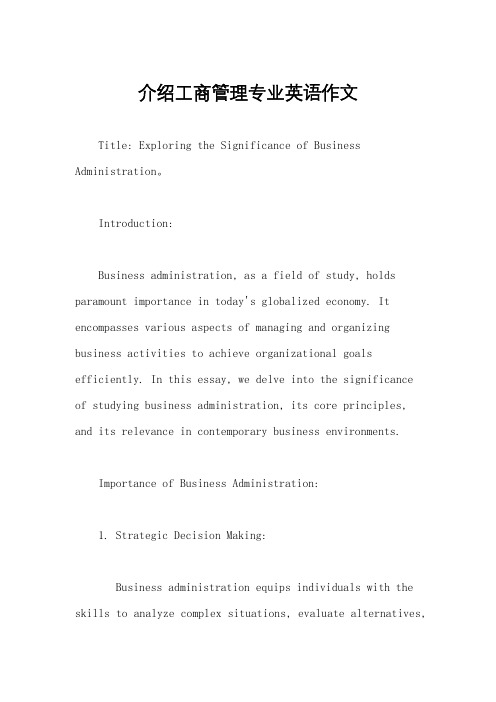
介绍工商管理专业英语作文Title: Exploring the Significance of Business Administration。
Introduction:Business administration, as a field of study, holds paramount importance in today's globalized economy. It encompasses various aspects of managing and organizing business activities to achieve organizational goals efficiently. In this essay, we delve into the significanceof studying business administration, its core principles, and its relevance in contemporary business environments.Importance of Business Administration:1. Strategic Decision Making:Business administration equips individuals with the skills to analyze complex situations, evaluate alternatives,and make informed decisions. Strategic decision-making lies at the heart of successful businesses, enabling them to adapt to dynamic market conditions and gain a competitive edge.2. Resource Allocation:Efficient allocation of resources, including financial, human, and material resources, is crucial for organizational success. Business administration professionals possess the expertise to allocate resources optimally, ensuring maximum productivity and profitability.3. Organizational Development:Business administration fosters organizational development by facilitating effective communication, teamwork, and leadership. Through strategic planning and implementation, businesses can enhance their operational efficiency and adaptability to changing market trends.4. Financial Management:Sound financial management is essential for the sustainability and growth of any business. Business administration education provides individuals with the knowledge and skills to manage budgets, analyze financial statements, and make sound investment decisions.5. Market Analysis and Strategy:Understanding market dynamics and consumer behavior is vital for developing successful business strategies. Business administration students learn how to conduct market research, identify market opportunities, and formulate marketing strategies to capitalize on them.Relevance in Contemporary Business Environments:1. Globalization:In an increasingly interconnected world, businesses operate in diverse cultural, political, and economic contexts. Business administration education preparesindividuals to navigate the complexities of globalization by fostering cross-cultural competence and international business acumen.2. Technological Advancements:Rapid technological advancements have transformed the way businesses operate and compete. Business administration programs incorporate courses on digital technologies, data analytics, and innovation management to equip students with the skills needed to thrive in the digital age.3. Sustainable Development:Sustainability has emerged as a key concern for businesses worldwide. Business administration curriculum often includes courses on sustainable business practices, corporate social responsibility, and environmental management, reflecting the growing emphasis on ethical and responsible business conduct.4. Entrepreneurship and Innovation:Business administration education nurtures entrepreneurial spirit and fosters innovation. Whether aspiring to launch a startup or drive innovation within existing organizations, business administration graduates are equipped with the knowledge and skills to identify opportunities, develop business plans, and execute innovative ideas.Conclusion:In conclusion, business administration plays a pivotal role in shaping the success and sustainability of businesses in today's dynamic and competitive landscape. By imparting strategic thinking, managerial expertise, and a global perspective, business administration education prepares individuals to tackle the challenges andcapitalize on the opportunities of the modern business world. As such, it remains a highly relevant and sought-after field of study for aspiring business professionals.。
中电国际财经类管培生英语考试

中电国际财经类管培生英语考试Here is the English essay based on the title you provided, with the text length exceeding 600 words as requested:As a candidate for the prestigious China Electric International Financial Management Trainee Program, I am excited to showcase my proficiency in the English language and my keen interest in the financial industry. This program presents an invaluable opportunity to hone my skills, gain invaluable industry insights, and contribute to the growth and development of this esteemed organization.My academic journey has been a testament to my dedication and passion for the field of finance. Graduating with a degree in Finance from a reputable university, I have developed a strong foundation in financial principles, analytical techniques, and decision-making processes. Throughout my studies, I have consistently demonstrated a keen aptitude for problem-solving, critical thinking, and effective communication - all essential qualities for success in this dynamic industry.Beyond the classroom, I have actively sought out opportunities to expand my knowledge and practical experience. I have participatedin various finance-related case competitions, where I have collaborated with diverse teams to analyze complex financial scenarios and devise strategic solutions. These experiences have not only sharpened my technical skills but have also honed my ability to work effectively in a team environment, adapt to changing circumstances, and present my ideas in a clear and convincing manner.Furthermore, I have proactively sought out internships and part-time roles within the financial sector. These hands-on experiences have allowed me to apply my academic knowledge to real-world situations, gaining valuable insights into the inner workings of financial institutions, the decision-making processes of industry leaders, and the evolving trends that shape the global financial landscape.One of the internships that has been particularly impactful was my time at a prestigious investment firm. During this experience, I was tasked with conducting in-depth market research, analyzing financial data, and assisting in the development of investment strategies. The exposure to the fast-paced and dynamic nature of the industry has not only solidified my passion for finance but has also inspired me to continuously expand my knowledge and stay at the forefront of industry developments.Alongside my academic and professional pursuits, I have also been an active member of my university's finance club. In this capacity, I have organized and participated in various events, workshops, and guest speaker sessions, where I have had the opportunity to engage with industry experts, network with like-minded individuals, and deepen my understanding of the financial landscape. These experiences have further reinforced my commitment to the field of finance and my desire to contribute to the growth and success of leading organizations such as China Electric International.As I look towards the future, I am confident that my academic achievements, practical experience, and passion for the financial industry make me an ideal candidate for the China Electric International Financial Management Trainee Program. I am eager to leverage the extensive resources and learning opportunities offered by this program to refine my skills, expand my knowledge, and contribute to the company's strategic objectives.Moreover, I am deeply committed to the values and principles that define China Electric International. I share the organization's dedication to innovation, sustainability, and ethical business practices, and I am eager to align my professional goals with the company's overarching vision. I believe that my diverse experiences, strong work ethic, and adaptability will enable me to thrive in the dynamic and challenging environment of this program, andultimately, contribute to the continued success of China Electric International.In conclusion, I am immensely grateful for the opportunity to be considered for the China Electric International Financial Management Trainee Program. I am confident that my academic achievements, practical experience, and passion for the financial industry make me a strong candidate for this prestigious program. I am eager to embark on this journey and leverage the resources and learning opportunities provided to further develop my skills, expand my knowledge, and contribute to the growth and success of China Electric International.。
商务英语选题
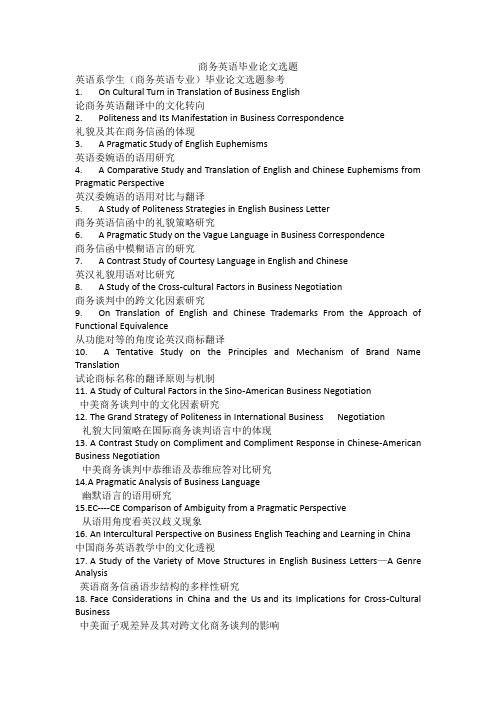
商务英语毕业论文选题英语系学生(商务英语专业)毕业论文选题参考1.On Cultural Turn in Translation of Business English论商务英语翻译中的文化转向2.Politeness and Its Manifestation in Business Correspondence礼貌及其在商务信函的体现3. A Pragmatic Study of English Euphemisms英语委婉语的语用研究4. A Comparative Study and Translation of English and Chinese Euphemisms from Pragmatic Perspective英汉委婉语的语用对比与翻译5. A Study of Politeness Strategies in English Business Letter商务英语信函中的礼貌策略研究6. A Pragmatic Study on the Vague Language in Business Correspondence商务信函中模糊语言的研究7. A Contrast Study of Courtesy Language in English and Chinese英汉礼貌用语对比研究8. A Study of the Cross-cultural Factors in Business Negotiation商务谈判中的跨文化因素研究9.On Translation of English and Chinese Trademarks From the Approach of Functional Equivalence从功能对等的角度论英汉商标翻译10. A Tentative Study on the Principles and Mechanism of Brand Name Translation试论商标名称的翻译原则与机制11.A Study of Cultural Factors in the Sino-American Business Negotiation中美商务谈判中的文化因素研究12.The Grand Strategy of Politeness in International Business Negotiation礼貌大同策略在国际商务谈判语言中的体现13.A Contrast Study on Compliment and Compliment Response in Chinese-American Business Negotiation中美商务谈判中恭维语及恭维应答对比研究14.A Pragmatic Analysis of Business Language幽默语言的语用研究15.EC----CE Comparison of Ambiguity from a Pragmatic Perspective从语用角度看英汉歧义现象16.An Intercultural Perspective on Business English Teaching and Learning in China中国商务英语教学中的文化透视17.A Study of the Variety of Move Structures in English Business Letters—A Genre Analysis英语商务信函语步结构的多样性研究18.Face Considerations in China and the Us and its Implications for Cross-Cultural Business中美面子观差异及其对跨文化商务谈判的影响19.Differences of Chinese and English Idioms in the Perspective of Cultural Difference从文化视角看英汉习语的差异20.The Analysis of Fuzziness in Advertising English广告英语的模糊性探析21.Metaphor in English Euphemism隐喻在英语委婉语中的应用22.Politeness Representation in English Business Correspondence商务英语信函中礼貌的表现23.Politeness Principles and Strategies in Business English商务英语的礼貌原则与策略24.Differences of Interpersonal Relationship between Eastern and Western People东西方人际关系要素差异探析parative Study of Language in Advertising between English &Chinese中西方广告语言比较26.Cultural Differences in Advertising between English &Chinese中西方广告中的文化差异27. Morphology in Advertising English广告英语的词汇特点28.Syntax in Advertising English广告英语的句法特点29.Rhetorical Devices in Advertising English广告英语的修辞方法30.Figure of Speech in Advertising of English & Chinese比喻在中西广告中的运用parative Study of Thinking Way between Chinese & English中西方思维方式比较32.On the Influence of Network Vocabulary on Chinese Language英语网络词汇对汉语的影响33.Application of Communicative Approach to the Teaching of Oral Business English 交际教学法与商务英语口语教学34.The Application of Case Study in Business English Teaching案例教学法在商务英语教学中的应用35.The Application of Situated Teaching Theory in Business English Teaching情境教学理论在商务英语教学中的运用36.On Fostering Communicative Competence in Business English Teaching试论商务英语教学中语言交际能力的培养37.The Application of Task-based Teaching in Business English Teaching任务教学法在商务英语教学中的应用ing Communicative Approach in Teaching Vocabulary in Business English Class 用交际教学思想指导商务英语教学中词汇教学39.Cultivation of Cross-cultural Communication in Business English Teaching商务英语教学中跨文化交际能力的培养work and Business English Teaching计算机网络与商务英语教学41.On Color Terms in Business English浅谈商务英语中的颜色词42.A Study on Formation of Neologisms in Business English商务英语新词构词研究43.Analysis of Business English Words' Characteristics商务英语词汇特点浅析44.The Lexical Features of E-commerce English and Its Translation电子商务英语的词汇特征及翻译45.On the Planning and Design of Business English商务英语课程设置的探讨46.On the Characteristics and Translating Skills of Business English商务英语的特点及翻译技巧47.The Use of Business English Correspondence in Business商务英语函电在对外贸易中的作用48.The Use of English in Business with Non-native English Speakers与非英语国家商务谈判中英语的运用49.On the Teaching of Spoken English in Business English商务英语专业口语课程教学探讨50.On the Business English Writing after China’s Entry into WTO入世商务英语写作的研究51.On the Writing Mistakes in Business English商务英语写作中的错误探讨52.On the Characteristics and Feature of International Commercial Contracts浅谈涉外合同英语特色53.On the Characteristics and Translating Skills of English Advertising广告英语的特征和翻译54.On the Teaching of English for Tourism旅游英语教学探讨55.Linguistic Analysis of Metaphor in Business Reading经贸英语阅读中隐喻现象的语言学分析56.Acronym in International Trade English and Its Translation国际贸易英语中的缩略语及其翻译57.Linguistic Tactics in Business Negotiation商务英语谈判中的语言策略58.Semantic Analysis of Business English Writing商务英语写作的语义学分析59.Analysis on the Feature of Business English vocabulary and Its Translation Tactics 商务英语词汇的特征分析及翻译策略60.Analysis of the Color Word in Business English商务英语中的颜色词分析61.Linguistic Feature of Business Advertisements and Its Translation商务广告的语言特点及其翻译62.Non-verbal Communication in Business Negotiation商务谈判中的非语言交际63.Linguistic Feature of Business English Correspondence and Its Application in International Trade外贸英语函电的语言特点及其在国际贸易中的应用64.Social Factors in the Evolution of Business English Words and Expressions商务英语语词演化的社会因素65.A Tentative Study of Cultural Similarities and Differences from the Public Service Advertisement in English and Chinese中英公益广告语言中的中西文化异同初探66.Translation of Business Words of Chinese Characteristic具有中国特色商业词汇的英译67.Stylistic Characteristics of English for Business Letters商务信函英语的文体特征68.Stylistic Characteristics of English for Business Contracts商务合同英语的文体特征69.Politeness Principles and Writing of Business Letters礼貌原则与商务信函写作70.A Study on Translation of Some Restrictive Words in International Business Contracts国际商务合同中一些限定词语的翻译研究71.Term Using of English Advertisement英语广告中的术语应用72.The Analysis on the Differences of Interpersonal Relationship between Eastern and Western People东西方人际关系要素差异探析73.The Comparison of Euphemism in Wording of Sino-Western Letters中西书信用语的委婉语比较74.The Role and Function of Communication Language in Business Negotiation沟通语言在商务谈判中的作用与功能75.The Characteristics and Translation Techniques of Business English商务英语的特点及翻译技巧76.The Role of Body-Language in Business English试论肢体语言在商务谈判中的作用77.The Status of documentary secretary in International Trade单证员在国际贸易中的地位78.The Translating Skills of English Business Correspondence商务英语函电翻译技巧79.Risk Prevention for Export Settlement浅谈出口结汇风险的防范80.The Reform of Tax Rebate System and Its Influence中国退税制度的改革及其影响81.Translation and Strategy of Trademarks商标名称的翻译与策略82.Business English and Business Communication商务英语与商务交际83.Status of Documentary Work in International settlement制单工作在国际结算中的地位84.Study of Tariff Barriers and Non-Tariff Barriers关税壁垒与非关税壁垒探讨85.Negotiation of Material Rewards浅谈实质利益谈判法86.New Problems of International E-Commerce Development国际电子商务发展面临的新问题87.Relationship Between the Business English Writing Mistakes and Business English Writing Teaching商务英语写作中的错误与商务英语写作教学之间的关系88.How to Prevent Credit Fraud如何防范信用证诈骗89.Etiquette in business negotiations礼仪在商务谈判中的作用90.Status and Prospects of Chinese Trade中国贸易的现状和前景91.The policy adjustment of the new trade protectionism and Chinese Trade’s Development新贸易保护主义的政策调整与我国贸易发展92.UCP600 - New Rules of L/CUCP600-信用证领域的新规则探讨93.Analysis of Tone in Business English Writing商务写作中的语气分析94.The Inspection Certificate in International Trade浅谈商检证书在国际贸易中的作用95.Cultural Factors in Business Activities试论文化因素对商务活动的作用96.How to Translate Well Daily Business Documents如何翻译好日常商务文书97.Announcements in Business Interview浅论商务面试中的注意事项98.Methods of Learning Business Oral English浅谈商务英语口语的学习方法99.The Application of Oral English in the Business Field英语口语在商务领域中的应用100.The Influence of Cultural Differences on the International Business negotiations 文化差异对国际商务谈判的影响。
课程名称中英文对照参考表
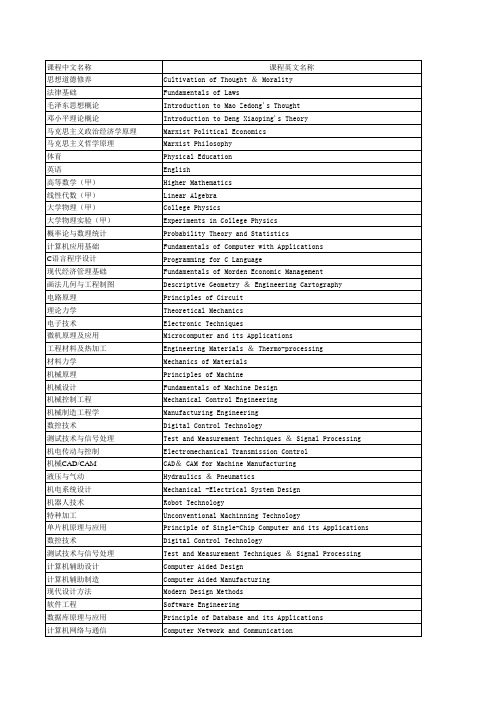
外国文学作选读Selected Reading of Foreign Literature现代企业管理概论Introduction to Modern Enterprise Managerment电力电子技术课设计Power Electronics Technology Design计算机动画设计3D Animation Design中国革命史China’s Revolutionary History中国社会主义建设China Socialist Construction集散控制DCS Distributed Control计算机控制实现技术Computer Control Realization Technology计算机网络与通讯Computer Network and CommunicationERP/WEB应用开发Application & Development of ERP/WEB数据仓库与挖掘Data Warehouse and Data Mining物流及供应链管理Substance and Supply Chain Management成功心理与潜能开发Success Psychology & Potential Development信息安全技术Technology of Information Security图像通信Image Communication金属材料及热加工Engineering Materials & Thermo-processing机械原理课程设计Course Design for Principles of Machine机械设计课程设计Course Design for Mechanical Design机电系统课程设计Course Design for Mechanical and Electrical System 创新成果Creative Achievements课外教育Extracurricular education。
ACCAF1StudyText,PDF原版BPP教材

Accountant in Business Paper F1 Course Notes ACF1CN07 l i BPP provides revision courses question days mock days and specific material to assist you in this important phase of your studies. F1 Accountant in Business Study Programme for Standard Taught Course Page Introduction to the paper and the course...............................................................................................................iii 1 Business organisation and structure...........................................................................................................1.1 2 Information technology and systems...........................................................................................................2.1 3 Influences on organisational culture............................................................................................................3.1 4 Ethical considerations........................................................................................................................ ..........4.1 5 Corporate governance and social responsibility..........................................................................................5.1 6 Home study chapter – The macro economic environment..........................................................................6.1 End of Day 1 – refer to Course Companion for Home Study 7 The business environment..........................................................................................................................7.1 8 Home study chapter – The role of accounting.............................................................................................8.1 9 Control security and audit............................................................................................................................9.1 10 Identifying and preventing fraud................................................................................................................10.1 11 Leadership and managing people.............................................................................................................11.1 12 Individuals groups teams.........................................................................................................................12.1 End of Day 2 – refer to Course Companion for Home Study Course exam 1 13 Motivating individuals and groups.............................................................................................................13.1 14 Personal effectiveness and communication..............................................................................................14.1 15 Recruitment and selection.........................................................................................................................15.1 16 Diversity and equal opportunities..............................................................................................................16.1 17 Training and development. (1)7.1 18 Performance appraisal (1)8.1 End of Day 3 – refer to Course Companion for Home Study Course exam 2 19 Answers to Lecture Examples...................................................................................................................19.1 20 Appendix: Pilot Paper questions................................................................................................................20.1 ??Revision of syllabus ?? Testing of knowledge ?? Question practice ?? Exam technique practice INTRODUCTION ii Introduction to Paper F1 Accountant in Business Overall aim of the syllabus To introduce knowledge and understanding of the business and its environment and the influence this has on how organisations are structured on the role of the accounting and other key business functions in contributing to the efficient effective and ethical management and development of an organisation and its people and systems. The syllabus The broad syllabus headings are: A Business organisation structure governance and management B Key environmental influences and constraints on business and accounting C History and role of accounting in business D Specific functions of accounting and internal financial control E Leading and managing individuals and teams F Recruiting and developing effective employees Main capabilities On successful completion of this paper candidates should be able to: ?? Explain how the organisation is structured governed and managed ?? Identify and describe the key environmental influences and constraints ?? Describe the history purpose and position of accounting ?? Identify and explain the functions of accounting systems ?? Recognise the principles of leadership and authority ?? Recruit and develop effective employees Links with other papers This diagram shows where direct solid line arrows and indirect dashed line arrows links exist between this paper and other papers that may follow it. The Accountant in Business is the first paper that students should study as it acts as an introduction to business structure and purpose and to accountancy as a core business function. BA P3 MA F2 and FA F3PA P1 AB F1 INTRODUCTION iii Assessment methods and format of the exam Examiner: Bob Souster The examination is a two hour paper-based or computer-based examination. Questions will assess all parts of the syllabus and will test knowledge and some comprehension of application of this knowledge. The examination will consist of 40 two mark and 10 one mark multiple choice questions. The pass mark is 50 ie. 45 out of 90. INTRODUCTION iv Course Aims Achieving ACCAs Study Guide Outcomes Business organisations structure governance and management A1 The business organisation and its structure Chapter 1A2 The formal and informal business organisation Chapter 3 A3 Organisational culture in business Chapter 3 A4 Stakeholders of business organisations Chapter 3 A5 Information technology and information systems in business Chapter 2 A6 Committees in the business organisation Chapter 1 A7 Business ethics and ethical behaviour Chapter 4 A8 Governance and social responsibility Chapter 5 Key environmental influences and constraints on business and accounting B1 Political and legal factors Chapter 7 B2 Macro-economic factors Chapter 6 B3 Social and demographic factors Chapter 7 B4 Technological factors Chapter 7 B5 Competitive factors Chapter 7 History and role of accounting in business C1 The history and functions of accounting in business Chapter 8 C2 Law and regulations governing accounting Chapter 8 C3 Financial systems procedures and IT applications Chapter 8 C4 The relationship between accounting and other business functions Chapter 1 Specific functions of accounting and internal financial control D1 Accounting and financial functions within business Chapter 1 D2 Internal and external auditing and their functions Chapter 9 D3 Internal financial control and security within business organisations Chapter 9 D4 Fraud and fraudulent behaviour and their prevention in business Chapter 10 INTRODUCTION v Leading and managing individuals and teams E1 Leadership management and supervision Chapter 11 E2 Individual and group behaviour in business organisations Chapter 12 E3 Team formationdevelopment and management Chapter 12 E4 Motivating individuals and groups Chapter 13 Recruiting and developing effective employees F1 Recruitment and selection managing diversity and equal opportunities Chapter 15 16 F2 Techniques for improving personal effectiveness at work and their benefits Chapter 14 F3 Features of effective communication Chapter 14 F4 Training development and learning in the maintenance and improvement of business performance Chapter 17 F5 Review and appraisal of individual performance Chapter 18 INTRODUCTION vi Classroom tuition and Home study Your studies for BPP consist of two elements classroom tuition and home study. Classroom tuition In class we aim to cover the key areas of the syllabus. To ensure examination success you will need to spend private study time reinforcing your classroom course with question practice and reviewing areas of the Course Notes and Study Text. Home study To support you with your private study BPP provides you with a Course Companion which helps you to work at home and aims to ensure your private study time is effectively used. The Course Companion includes a Home Study section which breaks down your home study by days one to be covered at the end of each day of the course. You will find clear guidance as to the time to spend on various activities and their importance. You are also provided with sample questions and either two course exams which should be submitted for marking as they become due or an I-pass CD which is full of questions. These may include questions on topics covered in class and home study. BPP Learn Online Come and visit the BPP Learn Online free at/acca/learnonline for exam tips FAQs and syllabus health check. ACCA Forum We have thriving ACCA bulletin boards at /accaforum. Register and discuss your studies with tutors and students. Helpline If you have any queries during your private study simply contact your class tutor on the telephone number or e-mail address that they will supply. Alternatively call 44 020 8740 2222 or your local training centre if outside the London area and ask for a tutor for this paper to speak to you or to call you back within 24 hours. Feedback The success of BPP’s courses has been built on what you the students tell us. At the end of the course for each subject you will be given a feedback form to complete and return. If you have any issues or ideas before you are given the form to complete please raise them with the course tutor or relevant head of centre. If this is not possible please email . INTRODUCTION vii Key to icons Question practice from the Study Text This is a question we recommend you attempt for home study. Real world examples These can be found in the Course Companion. Section reference in the Study Text Further reading is needed on this area to consolidate your knowledge. INTRODUCTION viii 1.1 Syllabus Guide Detailed Outcomes Having studied this chapter you will be able to: ?? Ascertain the appropriate organisational structure for different types and sizes of business. ?? Understand the concepts of span of control and scalar chains. ?? Appreciate the differing levels of strategy in an organisation. Exam Context This chapter lays the foundation for an understanding of what organisations are what they do and how they do it. Section 2 Organisational structure represents a higher level of knowledge. You must be able to apply knowledge to exam questions. Qualification Context An understanding of business structures is important with regard to higher level accounting papers as well as P3 Business Analysis. Business Context Appreciating why organisations are structured in different ways will help with an understanding of how they should be managed. Business organisation and structure 1: BUSINESS ORGANISATION AND STRUCTURE 1.2Overview Departments and functions Why does the organisation exist Structural forms Business hierarchy 1: BUSINESS ORGANISATION AND STRUCTURE 1.3 1 Organisations 1.1 Definition – An organisation is a social arrangement which pursues collective goals which controls its own performance and which has a boundary separating it from its environment. Boundaries can be physical or social. 1.2 Key categories: ?? Commercial ?? Not for profit ?? Public sector ?? Charities ?? Trade unions ?? Local authorities ?? Mutual associates Class exercise Required Identify a real-world example of the above categories of organisation. 1.3 Organisations owned or run by the government local or national or government agencies are described as being in the public sector. All other organisations are classified as the private sector. Limited liability 1.4 Limited companies denoted by X Ltd or X plc are set up so as to have a separate legal entity from their owners shareholders. Liability of these owners is thus limited to the amount invested. Private v public 1.5 Private companies are usually owned by a small number of people family members and these shares are not easily transferable. Shares of public companies will be traded on the Stock Exchange. Pg 52-561: BUSINESS ORGANISATION AND STRUCTURE 1.4 2 Organisational structure 2.1 Henry Mintzberg believes that all organisations can be analysed into five components according to how they relate to the work of the organisation and how they prefer to co-ordinate. a Strategic apex Drives the direction of the business through control over decision-making. b Technostructure Drives efficiency through rules and procedures. c Operating core Performs the routine activities of the organisation in a proficient and standardised manner. d Middle line Performs the management functions of control over resources processes and business areas. e Support staff Provide expertise and service to the organisation. Strategic Apex Support Staff Technostructure Middle Line Operating Core 1: BUSINESS ORGANISATION AND STRUCTURE 1.5 Exam standard question Required Match the following staff/rules to Mintzbergs technostructure: a Manager of a retail outlet supervising 40 staff. b A salesman responsible for twenty corporate accounts. c The owner of a start-up internet company employing two staff. d The HR department which provides support to business managers. e The IT department seeking to standardise internal systems. 3 Structural forms for organisations Scalar chain and span of control 3.1 As organisations grow in size and scope different organisational structures may be suitable. 3.2 The Scalar chain and Span of control determine the basic shape. The scalar chain relates to levels in the organisation and the span of control the number of employees managed. 3.3 Tall organisations have a: a Long scalar chain via layers of management b Hierarchy c Narrow span of control. 3.4 Flat organisations have a: a Short scalar chain less layers b Wide span of control. 1: BUSINESS ORGANISATION AND STRUCTURE 1.6 3.5 MD Divisional directors Department managers Section managers MD Supervisors Department managers Charge hands Supervisors Workers Workers Tall Flat Pilot paper Required Identify factors which may contribute to the length of the chain and the span of control. Organisational structures 3.6 Entrepreneurial A fluid structure with little or no formality. Suitable for small start-up companies the activities and decisions are dominated by a key central figure the owner/entrepreneur. 3.7 Functional This structure is created via separate departments or functions. Employees are grouped by specialism and departmental targets will be set. Formal communication systems will be set up to ensure information is shared. 1: BUSINESS ORGANISATION AND STRUCTURE 1.7 3.8 Matrix A matrix organisation crosses a functional with a product/customer/projectstructure. This structure was created to bring flexibility to organisations geared towards project work or customer-specific jobs. Staff may be employed within a hierarchy or within specific functions but will be slotted into different teams or tasks where their skill is most needed. The matrix structure is built upon the principles of flexibility and dual authority. Required Identify two advantages and two disadvantages of each structure. Advantages Disadvantages Entrepreneurial Functional Matrix 3.9 Organisations are rarely composed of only one type of structure especially if the organisation has been in existence for some time and as a consequence a hybrid structure may be established. Hybrid structures involve a mixture of functional divisionalisation and at least one other form of divisionalisation. Area Manager A Area Manager B Area Manager C.。
大学工商管理英语教材

大学工商管理英语教材IntroductionIn today's globalized world, English plays a crucial role in various fields, including business management. As a result, universities have developed specialized textbooks to cater to the needs of students studying business administration. This article aims to explore the characteristics and essential components of a comprehensive university-level business management English textbook.Chapter 1: Introduction to Business ManagementThis chapter provides an overview of the principles and concepts of business management. It covers topics such as the functions of management, different management theories, and the importance of effective communication within an organization. Additionally, it includes case studies and real-life examples to illustrate these concepts.Chapter 2: Organizational Behavior and LeadershipThis chapter delves into the study of human behavior within organizations and explores various leadership styles. It covers topics such as motivation, group dynamics, and the role of leadership in achieving organizational success. The chapter also emphasizes the importance of ethical behavior and decision-making in business management.Chapter 3: Marketing ManagementIn this chapter, students learn about the fundamentals of marketing management. It includes topics such as market research, segmenting andtargeting the market, developing marketing strategies, and analyzing consumer behavior. Practical exercises and case studies are provided to enhance students' understanding and application of marketing concepts.Chapter 4: Financial ManagementFinancial management is a crucial aspect of business administration. This chapter introduces students to the basics of financial management, including financial statement analysis, budgeting, and capital investment decisions. It also addresses the importance of financial planning and forecasting for sustainable business growth.Chapter 5: Human Resource ManagementThis chapter focuses on the management of human resources within organizations. It covers topics such as recruitment and selection, training and development, performance appraisal, and employee relations. The chapter also highlights the significance of effective human resource management in building a motivated and productive workforce.Chapter 6: Operations ManagementOperations management is essential for efficient production and service delivery. This chapter explores concepts such as production planning, supply chain management, quality control, and process improvement. Students are encouraged to think critically and apply these concepts to real-world business scenarios.Chapter 7: International BusinessIn today's interconnected world, international business plays a crucial role in the global economy. This chapter provides an overview of international trade, global market entry strategies, cultural considerations, and the challenges of managing multinational corporations. It also discusses the importance of cross-cultural communication and understanding in international business scenarios.Chapter 8: Entrepreneurship and Small Business ManagementEntrepreneurship is the driving force behind innovation and economic development. This chapter introduces students to the fundamentals of entrepreneurship, including opportunity identification, business planning, and risk management. It also emphasizes the unique challenges and opportunities associated with managing small businesses.ConclusionA comprehensive university-level business management English textbook should cover various aspects of business administration, including principles of management, marketing, finance, human resources, operations, international business, and entrepreneurship. By incorporating case studies, real-life examples, and practical exercises, such a textbook can provide students with the necessary knowledge and skills to excel in the field of business management.。
ALevelBusiness商务研究关键考点KeyTerms

Key Terms直接考定义、定义加content、只考相关content Consumer products 1 消费品Capital and intermediate goods 1 资本物品/中间物品Added value 1 2014 附加值Entrepreneur 2 企业家Social enterprise 3 2015 社会企业Primary sector 6 2015 第一产业Secondary sector 6 第二产业Tertiary sector 6 第三产业Private sector 7 私人部门/私营企业Public sector 7 2015 公共部门Privatisation 8 私有化Internal growth 15 2015 内部成长External growth 15 外部成长Corporate aim 20 公司宗旨Corporate objectives 20 2015 公司经营目标Mission statement 20 实名陈述Divisional/Departmental objectives 20 分部门目标Strategies 20 策略Management by objectives 21 目标管理Ethics 22 2014 企业道德规范Ethical code 22 2014 企业道德章程Stakeholder 25 2015 利益相关者Stakeholder concept 25Corporate social responsibility (CSR) 27 2015 2014 企业社会责任Social audit 28 社会责任审核Information technology 33 IT 信息技术Computer Aided Design(CAD) 33 计算机辅助设计Computer Aided Manufacturing(CAM) 33 计算机辅助制造Environmental audit 34 环境审核Pressure group 34 环境压力团体(环保组织)Economic growth 38 经济增长Gross Domestic Product (GDP) 38 国内生产总值Business cycle 38 经济周期/商业周期Recession 38 经济衰退Income elasticity of demand 38 收入需求弹性Inflation 38 2014 通货膨胀Unemployment 38 失业Cyclical unemployment 38 周期性失业Structural unemployment 38 结构性失业Frictional unemployment 38 摩擦性失业Fiscal policy 39 财政政策Monetary policy 39 货币政策Exchange rate 40 汇率Exchange rate appreciation 40 汇率升值Exchange rate depreciation 40 汇率贬值Manager 44 2015 经理Leadership 45 2015 领导力Worker’s representative 45 工人代表Leadership style 46 2014 领袖风格Autocratic leadership 46 专制型领导Laissez-faire leadership 46 放任式领导Democratic leadership 46 民主式领导Theory X managers 46 2014 X理论型管理者Theory Y managers 46 2014 Y理论型管理者Informal leadership 47 非正式性领导Emotional intelligence (EI) 47 2015 情商Motivation 49 2014 动机Self-actualisation 50 自我实现Job enrichment 51 职务丰富化(深度)Hygiene factors 51Motivating facors (motivators) 51 激发因素Valence 51Expectancy 51 期望Instrumentality 51Hourly wage rate 52 计时工资Piece rate 52 计件工资Salary 52 薪资Commission 52 销售提成Performance-related pay 52 绩效工资Profit sharing 52 利润分成Job rotation 53 轮岗Job enlargement 53 职务扩大化(广度)Job enrichment 53 职务丰富化(深度)Job redesign 53 职务再设计Quality circles 53 工人互助会/小组Worker participation 53 工作参与Team working 53 2014 团队化工作Human Resource Management 55 2015 2014 人力资源管理Hard HRM 55Soft HRM 55Workforce planning 56 2015 2014 劳动力使用规划Workforce audit 56 劳动力审查/考核Recruitment 57 2015 招聘Job description 57 职位描述Person specification 57 岗位具体要求Training 57 培训On-the -job training 57 在岗培训(岗位内培训)Induction training 57 入职培训Staff appraisal 57 工作评定Dismissal 58 解雇Unfair dismissal 58 不当解聘Redundancy 58 人员冗余Employment contract 59 劳动合同Temporary employment contract 59 短期/固定期劳动合同Part-time contract 59 兼职合同Flexi-time contract 59 弹性劳动合同(可伸缩劳动时间)Outsourcing 59 外包Trade union 64 工会Trade union recognition 65 雇方与工会的谈判Single union agreement 65 雇方只与一个工会谈判No-strike agreement 65 非罢工性协商Industrial action 65 工会措施Conciliation 65 劳动调解(第三方)Arbitration 65 劳动仲裁Level of hierarchy 68 工作层级Chain of command 68 指令链条Span of control 68 组织层级Matrix structure 69 矩阵结构Delegation 70 2015 授权Centralisation 70 集权Decentralisation 70 权力下放(分权)Line managers 71 基层经理(直线管理人员)Satff managers 71 人事经理Delayering 71 去层级化Effective communication 75 有效沟通Communication media 75 沟通媒介Communication barriers 76 沟通障碍One way 76 单向传达(群发式)Two way 76 双向沟通Marketing 80 2015 营销Consumer market s 80 2014 消费品市场Industrial market 80 工业品市场Marketing objectives 81 市场目标Market orientation 82 市场定位Product orientation 82 产品定位Asset led marketing 82 资产主导营销Societal marketing 82 社会营销Demand 82 需求Supply 82 供给Equilibrium price 82 均衡价格Market size 83 市场规模Market growth 83 市场规模增长率Market share 83 2015 市场份额Market share% 83 市场份额百分比Niche marketing 84 2014 细分市场Mass marketing 84 2015 大众市场Market segmentation 85 2014 市场划分Market segment 85 市场分区Consumer pro 消费者概况Market research 88 2014 市场调查Primary research 88 第一手调查Secondary research 88 第二手调查Qualitative research 88 定性调查Quantitative research 88 定量调查Focus group 89 目标群体Sample 89 抽样Random sample 89 随机抽样Systematic sample 89 系统抽样Stratified sampling 89 分层抽样Quota sampling 89 定额抽样Cluster sampling 89 分组抽样Open questions 90 开放式问题Closed questions 90 封闭式问题Range 92 区间范围Interquartile range 92 四分间距Marketing mix 94 2015 2014 销售计划Customer relationship marketing 95 客户关系营销Product life cycle 96 产品生命周期Price Elasticity of Demand(PED) 96 2015 需求价格弹性Promotion 101 促销Above the line promotion 101 2015 线上推广Below the line promotion 101 2015 线下推广Promotion mix 101 推广手段组合Advertising 101 2015 广告Sales promotion 101 2015 促销Promotional budget 102 促销预算Viral marketing 103 病毒式营销Channel of distribution 104 分销渠道Integrated marketing mix 104 整合营销组合Marketing plan 107 营销计划AIDA(Attention-Interest-Desire-Action) 109 艾达公式DAGMAR(Defining Advertising Goal for Measured AdvertisingResults) 109 广告效果评估体系New Product Development(NPD) 109 新产品开发Generate new product ideas 110 产生新产品创意Idea screening 110 创意筛选Concept development and testing 110 概念开发与测试Business analysis 110 业务分析Product testing 110 产品检测Test marketing 110 市场投放测试Commercialisation 110 商业化(全面投放)Research and Development (R and D) 110 新产品的调研与改进Globalisation114 全球化Multinational corporations 114 跨国公司International marketing 114 2014 国际市场营销Pan-global marketing 115 全球营销Global localisation 115 产品本地化Added value 119 附加值Production 119 生产Level of production 119 生产水平Efficiency 119 2015 效率Productivity 119 生产能力Labour intensive 119 2015 劳动力密集型Capital intensive 119 资本密集型Effectiveness 120 2015 2014 有效性(生产经营的有效性)Operations planning 123 2014 运营计划Operational flexibility 123 运营的灵活性Job production 123 2014 定制化生产Batch production 123 2015 2014 分批生产/间歇式生产Flow production 123 流水线生产Mass customisation 123 2014 大规模定制Process innovation 123 2015 流程创新Optimal location 125 最佳位置Quantitative factors 125 定量因素Qualitative factors 125 非定量因素Offshoring 125 海外建厂Multinational 125 跨国企业Trade barriers 125 贸易壁垒CAD 125 计算机辅助设计CAM 125 计算机辅助制造Scale of operation 126 经营规模Economies of scale 126 2015 规模经济Diseconomies of scale 126 2015 规模不经济Enterprise resource planning 127 企业资源计划Supply chain 127 供应链Inventory(stock) 131 **** **** 存货Economic order quantity 132 经济订货批量Buffer stocks 132 调节性库存储备Re-order quantity 132 再订购量Lead time 132 订货到交货的时间Just-in Time 132 即时生产Capacity utilisation 137 2015 产能利用率Excess capacity 137 闲置产能Rationalisation 138 减支Full capacity 138 极限产能/充分产能Capacity shortage 138 产能不足Outsourcing 138 外包Business Process Outsourcing(BPO) 138 经营流程外包(局部外包)Core activity 138 核心业务Lean production 142 精益生产Simultaneous engineering 142 并列工序Cell production 142 单元生产Kaizen 143 不断改进提高Quality product 144 优质产品Quality standards 144 品质标准Quality control 144 品控Quality assurance 144 品质保证TQM(Total Quality Management) 144 全面质量管理Internal customers 144 内部顾客Zero defects 144 零瑕疵ISO9000 144 国际标准体系Benchmarking 144 标杆学习Project 147 项目Project management 147 项目管理Critical path analysis 148 关键路径Network diagram 148 网络图Critical path 148 关键步骤Node 148 节点EST(Earliest Start Time) 148 最早开始时间LFT(Latest Finish Time) 148 最晚完成时间Total Float 148 2015 总机动时间Free Float 148 自由浮动时间Start up capital 152 启动资本Capital expenditure 152 资本性支出Revenue expenditure 152收益性支出Working capital 153 营运资本Liquidity 153 **** **** 流动性/流动资金Liquidation 153 清算Overdraft 155 2015 透支Factoring 155 保理/托收保付Long term loans 155 长期贷款Equity finance 155 权益融资Long term bonds/debentures 155 长期债券Rights issue 155 增股Venture capital 155 VC风险投资Business plan 156 商业计划书Cash 159 现金Cash flow 159 2015 现金流入量Cash inflows 159 现金流入Cash outflows 159 现金流出Liquidation 159 清算Insolvent 159 破产Cash flow forecast 160 2015 现金流量预测Overtrading 161 过度交易Debtors 163 债务人;借方Creditors 163 债权人;贷方Credit control 164 信用控制Bad debt 164 坏账Direct costs 166 **** **** 直接成本Indirect costs 166 间接成本Fixed costs 166 固定成本Variable costs 166 可变成本Break-even point of production 167 2015 2014 生产的盈亏平衡点Margin of safety 167 安全边际Cost centre 168 成本中心Profit centre 168 利润中心Overheads 168 杂项开支;日常管理费用Income statement 174 2015 损益表Balance sheet 175 资产负债表Budget 181 预算Budget holder 181 预算负责人Delegated budget 181 委派预算Incremental budgeting 182 增量预算Zero budgeting 182 零基预算Flexible budgets 182 弹性预算Variance 183 变动Favourable variance 183 有利差异(顺差)Adverse variance 183 不利差异Goodwill 185 商誉Intellectual property 185 知识产权Market value of company 185 公司市值Capital expenditure 185 资本性支出Revenue expenditure 186 收益性支出Depreciation 186 折旧;贬值Net realisable value 186 可变现净值Straight line depreciation 187 直线折旧法Net book value 187 NBV 账面净值Investment appraisal 195 投资估价Forecasted net cash flows 196 预测现金净流入量Criterion rate 196Criterion level 196Net Present Value(NPV) 197 2014 净现值Internal rate of return 198 内部收益率Corporate strategy 201 公司战略Tactical decision 202 战术决策Strategic management 202 战略管理Competitive advantage 203 竞争优势SWOT analysis 206 SWOT分析PEST analysis 207 PEST分析Vision statement 208 愿景陈述Mission statement 208 使命陈述Boston Matrix 208 波士顿矩阵Core competence 210 核心竞争力Core product 210 核心产品Ansoff’s Matrix 213 安索夫矩阵Force-field analysis 214 力场分析Decision tree 215 决策树Strategic implementation 219 战略实施Business plan 219 商业计划书Corporate culture 221 2014 企业文化Change management 222 2015 变革管理Project groups 223 项目组Project champions 223 项目负责人Contingency planning 223 应急计划2015PAPER1Style of business leadership 2015Business relocation 2015Finance expansion 2015Franchise 2015Benefits of becoming a franchisee 2015Cash flow vs. Profit 2015Using overdraft as a way of managing its cash flow 2015 Niche marketing and mass marketing 2015Marketing 2015Social enterprise 2015Emotional intelligence 2015How a business could improve its cash flow 2015Public limited company 2015Usefulness of the income statement for a public limited company 2015Usefulness of accounting ratios for assessing business performance 2015Product differentiation 2015Importance of having an effective system of recruitment for a business 2015External recruitment vs. Internal promotion 2015 Stakeholder 2015Two ways a public limited company is accountable to its stakeholders 2015Process innovation 2015Two ways a manufacturing business could use process innovation to improve efficiency and effectiveness 2015 How cost data can be used to monitor and improve business performance 2015Management 2015Roles of management 2015‘above the line’and ‘below the line’methods of promotion 2015Importance of branding for effective product promotion 2015Factors 2015Factors that could affect the decision on how to finance this investment 2015Why a business might have a high rate of labour turnover 2015How to solve the problem of passenger complaints about poor customer service 2015PAPER2Internal growth 2015Internal recruitment 2015Forecast current ratio 2015Liquidity forecast 2015Factors that should be considered when choosing new director 2015Marketing mix 2015Market share 2015Efficiency 2015Closing balance 2015Usefulness of cash flow forecasting 2015Benefits of setting business objectives for the short,medium and long term 2015Inventory control 2015Direct cost 2015Equity 2015Break even 2015Portfolio analysis 2015External finance 2015Inventory 2015Labour turnover 2015Disadvantages of high labour turnover 2015How to solve human resource problems 2015Importance of corporate responsibility 2015Economies of scale 2015Inventory control 2015Price elasticity of demand 2015Usefulness of price elasticity of demand 2015Financial problems 2015Importance of applying the concepts of the 4Cs to improve the relationship between company and customers 2015 Unit cost 2015Labour intensive 2015Calculation about break even 2015Usefulness of break-even 2015Analyse the factors that might influence the success of the company 2015PAPER3Evaluation of an extensive product portfolio 2015 Calculate gearing ratio 2015Current dividend 2015Proposed dividend 2015Sources of finance used to pay for the new factory 2015 How to choose sites for the new factory 2015Importance of corporate social responsibility when aiming to maximise shareholder value 2015Effective management of human resources 2015SWOT and PEST 2015How the directors could ensure the future strategic changes are implemented successfully 2015Benefits and limitations of the level of delegation 2015 Calculate capacity utilisation 2015Calculate average cost 2015Calculate the net profit margin 2015Ways in which the net profit margin could be increased 2015Problems that the company might experience if it buys another company 2015Discuss whether the company should always consider the interests of stakeholders as more important than profit 2015Importance of several data 2015Discuss how the strategy of entering the new market could be effectively implemented by directors 2015Benefits of effective internal communication 2015 Calculate the total float 2015Usefulness of critical path analysis when managing the change in the production line 2015Calculate the total contribution of (2015)Calculate promotional elasticity of demand 2015 Calculate price elasticity of demand 2015Whether the company should reduce price or increase promotional expenditure in order to increase sales. 2015 CSR 2015Whether the data is sufficient to enable the company to develop an effective strategic plan 2015Importance of the effective management of change for the future success 20152014PAPER1Marketing mixImportance of place with the marketing mixLabour turnoverExplain ways human resource management could help a business achieve its objectivesImportance of cash flow forecastingOperations managementExplain how changes in technology could affect the operations management of a businessDifferences between the motivation theories of Maslow and HerzbergDiscuss the view that a successful business needs both effective managers and effective leadersDifferences between batch production and flow production methodsDiscuss the implications for a manufacturing business of changing from batch production to flow productionMarket segmentationBriefly explain ways a hotel could segment the market for hotel accommodationState the formula for one accounting ratio that could be used to measure the liquidity of a businessBriefly explain two factors that could affect the profitability of a businessExplain why the objectives of a business could change over timeValue addedExplain ways operations management could contribute to the success of a businessDifferences between McGregor’s ‘Theory X’ and ‘Theory Y’Benefits of team working for production workers and managersHow a cell phone manufacturer could assess the effectiveness of its market research expenditureHow the effectiveness of the operations management function can be influenced by human resource managementHow the actions of competitors could influence the operations management decisions of a manufacturerNiche marketingDisadvantages of a niche marketing strategyDisciplinary procedureReasons why disciplinary procedures are important for a business when managing its employeesExplain factors that could affect the level of inventory held by a businessBreak-evenUses of break-even analysis for a manufacturing business Why a business could decide to use only non-financial rewards to improve the motivation of its workforceDiscuss the view that effective workforce planning is a necessary requirement for successful business performance Advantages and drawbacks for a business of setting corporate responsibility objectivesHow the main differences between the legal structures of a sole traders and public limited companies affect the way such business are financedHow cost information could be used to monitor and improve the performance of a hotel businessPAPER2Dynamic pricingTrade receivablesCalculate labour productivityComment on changes in productivityAnalyse the changes in liquidityDiscuss the view that the company should have corporate responsibility as a business objectivesPublic limited companyDirect costsCalculate market shareWhy maintaining market share might not be a suitable objectivesAnalyse the likely impact on competitiveness of the proposed changes to its marketing mixDiscuss the extent to which the new employment contracts will help TQ improve its performanceConsumer market4PsCalculate the labour turnover rateSuitable method for reducing labour turnoverImpact on profits resulting from moving into international marketsImpact on stakeholders of a change from batch production to mass customisationJob productionJITAdvantage and disadvantage to the employees of being a co-operativeAnalyse possible sources of finance suitable for opening the new shopEvaluate the leadership style used by the Managing Director. Portfolio analysisInventoryUsing data, analyse the impact on forecast liquidity if the company decides to expand the businessAnalyse one factor that will influence the likely success of the proposal to reduce pricesDiscuss what the partner should do about the fall in motivation of managers and employeesPrice discrimination4CsCalculate retained profitComment on the trend in retained profitAnalyse the factors that the company needs to consider when deciding whether to relocate the call centre back to country X Discuss the extent to which the company is behavingunethicallyPAPER3Benefits of operating ethically towards its stakeholders Calculate gross profit marginCalculate net profit marginRecommend a marketing plan which could increase profit marginsImpact on employee efficiency of increased use of technology Calculate payback periodCalculate net present value(NPV)Using information, assess whether the company should go ahead with Strategy ARecommend an improved organisational structure for the Research and Development departmetnAssess the usefulness to directors of the data and the other information provided when making the strategic decision whether to take over another companyHow to change the corporate culture if the company takes over another companyAnalyse how the Government’s policies to cut the rate of inflation are likely to affect the companyCalculate pay back periodCalculate NPV at a discount rate of 12%Using information,discuss whether further research and development expenditure is advisableEvaluate the sources of finance the company could consider for the development of the siteCalculate the expected monetary values for the 3 options Using information,recommend which of the 3 options for the site should be chosen.Discuss whether the company should be more accountable to its stakeholders by reporting on its CSR activities in its Annual ReportDiscuss how the strategic decision to close a factory should be implementedEvaluate the extent to which more effective long term planning might influence the company’s future success Analyse the advantage to the company of market segmentationDiscuss the factors that are likely to influence the decision of whether to introduce JIT inventory controlCalculate average rate of return(ARR)Calculate net present value(NPV)Using information,recommend whether the company shouldinvest in..Discuss whether the company should consider increasing its pay offer to employeesRefer to the data.Evaluate how the forecast changes macroeconomic performance might influence the company’s future profitabilityEvaluate the importance of planning in company’s strategy Evaluate how strategic analysis might aid company’s management when taking strategic decisionsPortfolio analysis 2015 2014Price discirmination 20144Ps 2015 20144Cs 2015 2014Profit margin 2015 2014Gross profit margin 2014 毛利率Net profit margin 2014Efficiency 2015Employee efficiency 2014Payback period 2014Organisational structure 2014Expected monetary values 2014Long term planning 2014Average rate of return 2014 Strategic decision 2014 Strategic analysis 2014 Dynamic pricing 2014 Trade receivables 2014 Labour productivity 2014。
Study On the Cultural Adaptation in International Business 商务英语专业毕业论文
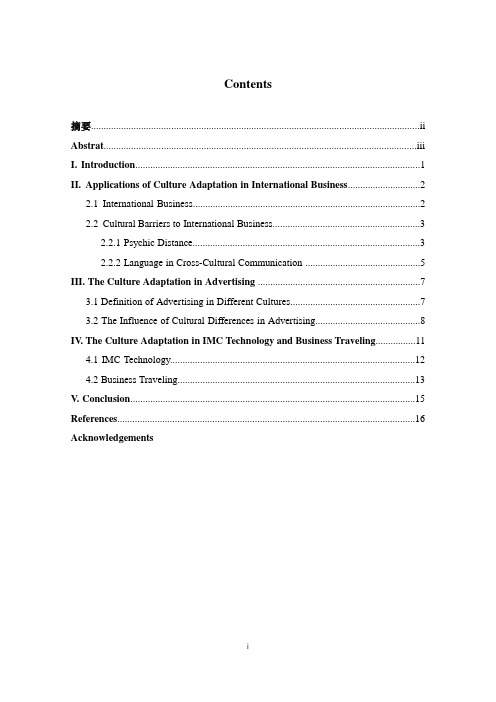
Contents摘要 (ii)Abstrat (iii)I. Introduction (1)II.Applications of Culture Adaptation in International Business (2)2.1International Business (2)2.2Cultural Barriers to International Business (3)2.2.1 Psychic Distance (3)2.2.2 Language in Cross-Cultural Communication (5)III. The Culture Adaptation in Advertising (7)3.1 Definition of Advertising in Different Cultures (7)3.2 The Influence of Cultural Differences in Advertising (8)IV.The Culture Adaptation in IMC Technology and Business Traveling (11)4.1 IMC Technology (12)4.2 Business Traveling (13)V. Conclusion (15)References (16)Acknowledgements摘要在世界经济飞速发展的今天,全球一体化进程加快。
国际范围内的商务活动日益频繁,跨文化交际成为经济活动的主要内容。
由于文化差异的存在,跨国经济活动中的文化冲突现象无处不在,大大阻碍了经济的发展。
为解决文化障碍,跨国企业在实践中开始重视文化适应问题。
然而国际商务中的文化适应是一个新的课题,企业者对文化及文化适应等概念认识不够,文化差异和文化适应意识不强。
本文介绍了什么是国际商务,国际商务中的文化障碍,广告和跨国企业的文化适应。
英语业务进修计划
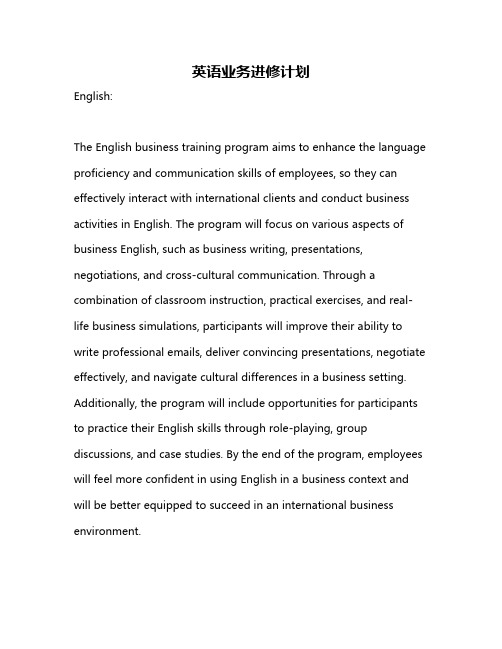
英语业务进修计划English:The English business training program aims to enhance the language proficiency and communication skills of employees, so they can effectively interact with international clients and conduct business activities in English. The program will focus on various aspects of business English, such as business writing, presentations, negotiations, and cross-cultural communication. Through a combination of classroom instruction, practical exercises, and real-life business simulations, participants will improve their ability to write professional emails, deliver convincing presentations, negotiate effectively, and navigate cultural differences in a business setting. Additionally, the program will include opportunities for participants to practice their English skills through role-playing, group discussions, and case studies. By the end of the program, employees will feel more confident in using English in a business context and will be better equipped to succeed in an international business environment.中文翻译:英语业务进修计划旨在提高员工的语言能力和沟通技巧,使他们能够有效地与国际客户互动并在英语环境下开展业务活动。
涉外业务英语如何学好
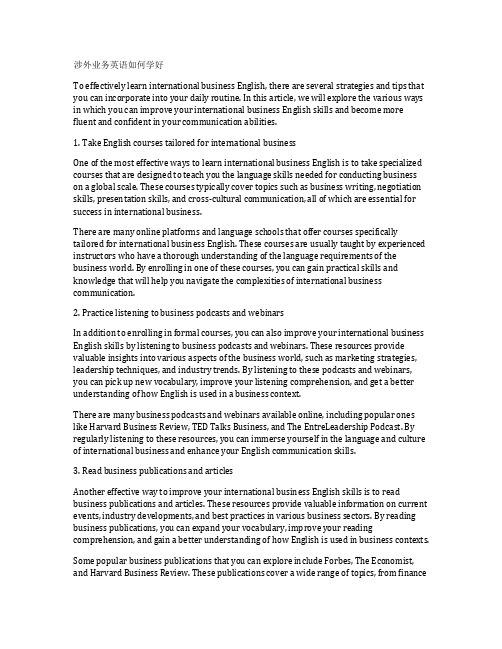
涉外业务英语如何学好To effectively learn international business English, there are several strategies and tips that you can incorporate into your daily routine. In this article, we will explore the various ways in which you can improve your international business English skills and become more fluent and confident in your communication abilities.1. Take English courses tailored for international businessOne of the most effective ways to learn international business English is to take specialized courses that are designed to teach you the language skills needed for conducting business on a global scale. These courses typically cover topics such as business writing, negotiation skills, presentation skills, and cross-cultural communication, all of which are essential for success in international business.There are many online platforms and language schools that offer courses specifically tailored for international business English. These courses are usually taught by experienced instructors who have a thorough understanding of the language requirements of the business world. By enrolling in one of these courses, you can gain practical skills and knowledge that will help you navigate the complexities of international business communication.2. Practice listening to business podcasts and webinarsIn addition to enrolling in formal courses, you can also improve your international business English skills by listening to business podcasts and webinars. These resources provide valuable insights into various aspects of the business world, such as marketing strategies, leadership techniques, and industry trends. By listening to these podcasts and webinars, you can pick up new vocabulary, improve your listening comprehension, and get a better understanding of how English is used in a business context.There are many business podcasts and webinars available online, including popular ones like Harvard Business Review, TED Talks Business, and The EntreLeadership Podcast. By regularly listening to these resources, you can immerse yourself in the language and culture of international business and enhance your English communication skills.3. Read business publications and articlesAnother effective way to improve your international business English skills is to read business publications and articles. These resources provide valuable information on current events, industry developments, and best practices in various business sectors. By reading business publications, you can expand your vocabulary, improve your reading comprehension, and gain a better understanding of how English is used in business contexts. Some popular business publications that you can explore include Forbes, The Economist, and Harvard Business Review. These publications cover a wide range of topics, from financeand economics to marketing and management, and can provide you with valuable insights into the complexities of the business world. By reading these publications regularly, you can stay informed about the latest trends and developments in international business and enhance your English language skills at the same time.4. Engage in language exchange programsLanguage exchange programs are a great way to practice your international business English skills and improve your fluency in the language. These programs typically involve pairing up with a native English speaker who wants to learn your native language, and then communicating with each other in both languages. By engaging in a language exchange program, you can improve your speaking and listening skills, expand your vocabulary, and gain insight into the cultural nuances of the English language.There are many online platforms and apps that facilitate language exchange programs, such as Tandem, HelloTalk, and ConversationExchange. These platforms allow you to connect with language partners from around the world and practice your English skills in a supportive and interactive environment. By participating in language exchange programs, you can gain real-world experience in using international business English and become more confident in your communication abilities.5. Attend networking events and conferencesNetworking events and conferences provide excellent opportunities to practice your international business English skills and connect with professionals from different countries. These events bring together industry experts, business leaders, and entrepreneurs from around the world, giving you the chance to engage in meaningful conversations and expand your professional network. By attending networking events and conferences, you can practice your English speaking and listening skills, learn about the latest industry trends, and gain valuable insights into the global business landscape.To make the most of networking events and conferences, it is important to come prepared with a list of conversation starters and questions to ask other participants. This will help you engage in meaningful discussions and showcase your international business English skills. Additionally, you can take advantage of networking opportunities to exchange business cards, connect with potential partners or clients, and build valuable relationships that can support your professional growth.6. Practice writing business emails and reportsEffective written communication is a crucial skill in international business, as it allows you to convey your ideas, proposals, and recommendations in a clear and professional manner. To improve your international business English writing skills, it is important to practice writing business emails, reports, and other documents on a regular basis. By honing your writing skills, you can enhance your ability to communicate effectively with colleagues, clients, and stakeholders from different cultural backgrounds.When writing business emails and reports, it is important to pay attention to the tone, style, and structure of your communication. Be concise and to the point, use formal language and professional etiquette, and proofread your documents carefully to ensure accuracy and clarity. By practicing writing business emails and reports, you can enhance your international business English skills and build confidence in your ability to communicate effectively in a business context.7. Hire a language coach or tutorIf you are serious about improving your international business English skills, you may consider hiring a language coach or tutor to provide personalized guidance and feedback. A language coach can help you identify your strengths and weaknesses in English communication, develop a customized learning plan that suits your needs and goals, and provide ongoing support and encouragement as you progress in your language learning journey.A language coach can also help you set realistic goals for improving your international business English skills, track your progress, and adapt your learning strategies as needed. By working with a language coach, you can receive personalized instruction and feedback that can accelerate your language learning and help you achieve fluency in international business English.8. Immerse yourself in the language and cultureFinally, one of the best ways to improve your international business English skills is to immerse yourself in the language and culture of English-speaking countries. By surrounding yourself with native English speakers and engaging in authentic language experiences, you can accelerate your language learning and gain a better understanding of how English is used in real-world business contexts.There are many ways to immerse yourself in the language and culture of English-speaking countries, such as traveling to an English-speaking country, participating in cultural exchange programs, or attending language immersion programs. By immersing yourself in the language and culture, you can practice your English communication skills in real-life situations, build confidence in your abilities, and gain a deeper appreciation for the nuances of the English language.In conclusion, learning international business English is a valuable skill that can open up new opportunities and enhance your career prospects in the global business arena. By incorporating these strategies and tips into your language learning routine, you can improve your international business English skills and become more fluent and confident in your communication abilities. Whether you are a seasoned professional in international business or a new graduate entering the workforce, mastering international business English can help you succeed in today's competitive and interconnected business world. With dedication, practice, and perseverance, you can achieve fluency in international business English and take your career to new heights.。
学习商科的好处英语作文
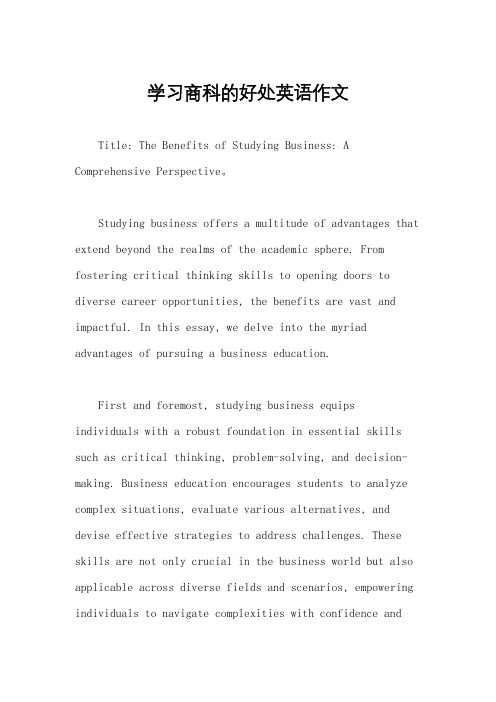
学习商科的好处英语作文Title: The Benefits of Studying Business: A Comprehensive Perspective。
Studying business offers a multitude of advantages that extend beyond the realms of the academic sphere. From fostering critical thinking skills to opening doors to diverse career opportunities, the benefits are vast and impactful. In this essay, we delve into the myriad advantages of pursuing a business education.First and foremost, studying business equipsindividuals with a robust foundation in essential skills such as critical thinking, problem-solving, and decision-making. Business education encourages students to analyze complex situations, evaluate various alternatives, and devise effective strategies to address challenges. These skills are not only crucial in the business world but also applicable across diverse fields and scenarios, empowering individuals to navigate complexities with confidence andacumen.Moreover, studying business cultivates a deep understanding of economic principles and market dynamics. By delving into subjects like microeconomics, macroeconomics, and market analysis, students gain insights into the forces driving global economies and the interconnectedness of markets. This knowledge not only fosters informed decision-making in business but also enables individuals to comprehend and respond to broader economic trends and phenomena.Furthermore, business education fosters creativity and innovation. Through courses on entrepreneurship, innovation management, and design thinking, students are encouraged to think outside the box, identify emerging opportunities, and develop groundbreaking solutions. The entrepreneurial mindset instilled in business students encourages them to embrace risk, persevere in the face of challenges, and transform ideas into tangible ventures, thereby driving economic growth and societal progress.Additionally, studying business nurtures effective communication and interpersonal skills. In a business environment characterized by collaboration and teamwork,the ability to articulate ideas persuasively, negotiate effectively, and build meaningful relationships is paramount. Business education emphasizes communication strategies, conflict resolution techniques, and leadership principles, empowering individuals to excel in diverse professional settings and foster productive collaborations.Furthermore, studying business provides a global perspective and fosters cultural competence. In an increasingly interconnected world, businesses operate in diverse cultural contexts, necessitating cross-cultural understanding and adaptability. Business education exposes students to international markets, global business practices, and cultural nuances, preparing them to navigate the complexities of a multicultural environment with sensitivity and respect.Moreover, studying business offers abundant career opportunities across a wide range of industries and sectors.Whether pursuing careers in finance, marketing, operations, or entrepreneurship, the skills and knowledge acquired through a business education are highly transferable andin-demand. From multinational corporations to startups, from the public sector to nonprofit organizations, business graduates are sought after for their versatile skill set and strategic thinking.In conclusion, studying business yields a plethora of benefits that extend far beyond the confines of the classroom. From fostering critical thinking and problem-solving skills to nurturing creativity and cultural competence, the advantages are manifold. Whether aspiring to launch a startup, climb the corporate ladder, or make a positive impact in society, a business education provides the tools, insights, and opportunities to succeed intoday's dynamic and interconnected world.。
chapter-3-Forms-of-Business-Organization
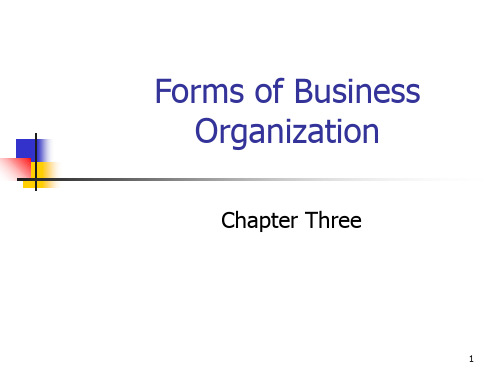
Defபைடு நூலகம்nition
Sole
Partner
proprietor ship
ship
Corpora tion
Advantages
Disadvantages
28
29
Conclusion:compare the three
forms and fill in the forms
Sole Partner Corporation
propriet orship
ship
ownership
liability
investment
management tax
life span
30
Other types of Business Organization
Joint Venture, Technical Partnership and Syndicate
service business & goods-producing business
finance & insurance transportations & utilities wholesale & retail trade other services like banking
5
Service business
❖ Syndicates (联合企业, 辛迪加)are temporary associations of two or more firms, usually for mutual investment.
32
Cooperative (合作社) ❖ A cooperative is owned and controlled by
出纳英语学习计划大学
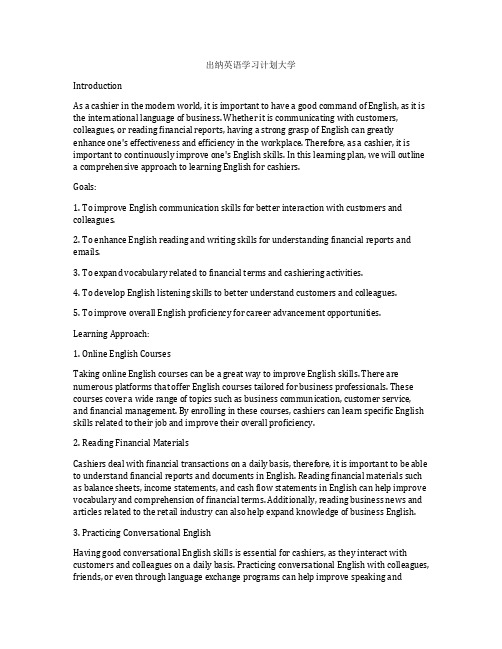
出纳英语学习计划大学IntroductionAs a cashier in the modern world, it is important to have a good command of English, as it is the international language of business. Whether it is communicating with customers, colleagues, or reading financial reports, having a strong grasp of English can greatly enhance one's effectiveness and efficiency in the workplace. Therefore, as a cashier, it is important to continuously improve one's English skills. In this learning plan, we will outline a comprehensive approach to learning English for cashiers.Goals:1. To improve English communication skills for better interaction with customers and colleagues.2. To enhance English reading and writing skills for understanding financial reports and emails.3. To expand vocabulary related to financial terms and cashiering activities.4. To develop English listening skills to better understand customers and colleagues.5. To improve overall English proficiency for career advancement opportunities.Learning Approach:1. Online English CoursesTaking online English courses can be a great way to improve English skills. There are numerous platforms that offer English courses tailored for business professionals. These courses cover a wide range of topics such as business communication, customer service, and financial management. By enrolling in these courses, cashiers can learn specific English skills related to their job and improve their overall proficiency.2. Reading Financial MaterialsCashiers deal with financial transactions on a daily basis, therefore, it is important to be able to understand financial reports and documents in English. Reading financial materials such as balance sheets, income statements, and cash flow statements in English can help improve vocabulary and comprehension of financial terms. Additionally, reading business news and articles related to the retail industry can also help expand knowledge of business English.3. Practicing Conversational EnglishHaving good conversational English skills is essential for cashiers, as they interact with customers and colleagues on a daily basis. Practicing conversational English with colleagues, friends, or even through language exchange programs can help improve speaking andlistening skills. Role-playing common cashier-customer scenarios can also help in practicing practical English communication skills.4. Writing PracticeAs part of their job, cashiers may need to write emails, reports, or other documents in English. Improving writing skills through practice and feedback is essential. Keeping a journal or writing short essays on relevant topics can help in improving writing fluency and accuracy.5. Vocabulary ExpansionExpanding vocabulary related to financial terms and cashiering activities is crucial for effective communication in the workplace. Memorizing and practicing using relevant vocabulary can greatly improve professional communication skills.Timeline:Month 1-2:- Enroll in an online English course tailored for business professionals and complete the modules related to customer service and business communication.- Start reading finance and business news articles in English to familiarize oneself with financial terms and business English.Month 3-4:- Practice conversational English with colleagues or friends, focusing on common cashier-customer scenarios.- Start writing practice by maintaining a journal or writing short essays on topics related to cashiering activities.Month 5-6:- Enroll in an advanced English course focused on financial management and complete relevant modules.- Continue reading and expanding vocabulary related to cashiering and financial terms. Month 7-8:- Practice listening skills by watching English documentaries or podcasts related to finance and business.- Continue writing practice and seek feedback from colleagues or language exchange partners.Month 9-10:- Review and consolidate all the skills learned in the past months by engaging in regular conversations and writing activities.- Take a proficiency test to assess the progress and identify areas for further improvement. ConclusionContinuous learning and improvement of English skills is essential for cashiers to excel in their roles. By following this comprehensive learning plan, cashiers can enhance their English communication, reading, writing, and listening skills, and ultimately improve their overall proficiency. This will not only benefit their current job but also open up new career advancement opportunities in the future.。
商务英语写作Lesson11

目录
• Overview of Business English Writing • Business English Writing Skills • Analysis of Business English Writing Examples
Competitiveness
In today's global business environment, profitability in English writing is a key skill for success
Basic Principles of Business English Writing
professional Avoiding using colloquial language or slang
Business email writing
Example ```Markdown
Subject: Request for Proposal
Business email writing
Format
Business emails commonly follow a formal structure, including a meeting, body, closing, and signature
03
Language and Tone
The language should be formal and the tone should be
03
Analysis of Business English Writing Examples
Business email writing
商务英语毕业论文写作指导

Conclusion
Summarize the main points of the study, reiterate the research objectives and their achievement, and propose future research directions based on the findings
• Citation style: Students should follow a standard citation style, such as APA or MLA, when writing their theses This helps to ensure that their work is properly distributed and cited, and it also follows academic conventionterature review
Principles and Techniques for Selecting Topics
Relevance to Business English: Ensure that the topic is closely related to the field of Business English, considering its practical applications in the business world
03 Paper Structure and Outline
如何学习商务英语专业的英语作文

如何学习商务英语专业的英语作文Title: How to Study Business English MajorIn today's globalized world, having proficiency in business English is essential for success in the business world. Whether you are a student studying business English or a working professional looking to improve your skills, there are several key strategies you can employ to enhance your learning experience.First and foremost, it is crucial to immerse yourself in the language. This can be achieved through various methods such as watching English language movies and TV shows, listening to English music, and reading English books and newspapers. By exposing yourself to the language in different contexts, you can improve your vocabulary, grammar, and pronunciation.In addition to immersion, practice is key to mastering any language. Make an effort to speak and write in English as much as possible, whether it's through daily conversations with classmates or colleagues, or by writing essays and reports in English. Joining a language exchange program or finding a study buddy who is also learning business English can provide you with valuable opportunities to practice and improve your skills.Furthermore, taking advantage of available resources such as online courses, language learning apps, and business English textbooks can help you deepen your understanding of the language. Many universities and language schools offer specialized courses in business English that cover topics such as business communication, negotiations, and presentations. These courses can provide you with the knowledge and skills needed to succeed in the business world.Another effective strategy for studying business English is to engage in real-world experiences. This can include participating in internships, attending business conferences and seminars, or even networking with professionals in the field. By immersing yourself in real business situations, you can gain practical experience and insights that can enhance your language skills and understanding of business practices.Finally, staying motivated and setting goals for yourself is essential to your success in studying business English. Whether your goal is to pass a language proficiency exam, land a job with an international company, or simply improve your communication skills, having a clear vision of what you want to achieve can help you stay focused and motivated throughout your learning journey.In conclusion, studying business English requires dedication, practice, and a willingness to step out of your comfort zone. By immersing yourself in the language, practicing regularly, utilizing resources, engaging in real-world experiences, and setting goals for yourself, you can enhance your language skills and increase your chances of success in the business world. Remember, learning a new language is a process that takes time and effort, but the rewards are well worth it. Good luck on your journey to mastering business English!。
国内外学术期刊分类
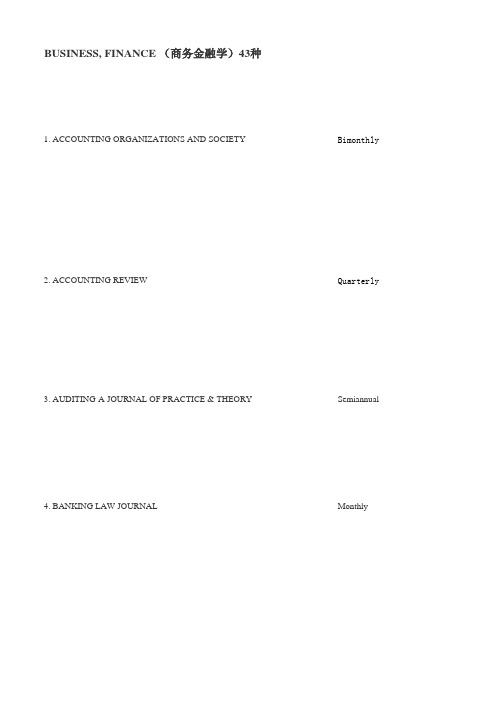
BUSINESS, FINANCE (商务金融学)43种1. ACCOUNTING ORGANIZATIONS AND SOCIETY Bimonthly2. ACCOUNTING REVIEW Quarterly3. AUDITING-A JOURNAL OF PRACTICE & THEORY Semiannual4. BANKING LAW JOURNAL Monthly5. CONTEMPORARY ACCOUNTING RESEARCH Quarterly6. FINANCE A UVER Monthly7. FINANCE AND STOCHASTICS Quarterly8. FINANCIAL ANALYSTS JOURNAL Bimonthly9. FINANCIAL MANAGEMENT Quarterly10. FISCAL STUDIES Quarterly11. FORBES Biweekly12. GENEVA PAPERS ON RISK AND INSURANCE THEORY Semiannual13. GENEVA PAPERS ON RISK AND INSURANCE-ISSUES AND PRACTICEQuarterly14. IMF STAFF PAPERS Tri-annual15. INTERNATIONAL JOURNAL OF FINANCE & ECONOMICS Quarterly16. JOURNAL OF ACCOUNTING & ECONOMICS Bimonthly17. JOURNAL OF ACCOUNTING RESEARCH Bimonthly18. JOURNAL OF BANKING & FINANCE Monthly19. JOURNAL OF CORPORATE FINANCE Quarterly20. JOURNAL OF FINANCE Bimonthly21. JOURNAL OF FINANCIAL AND QUANTITATIVE ANALYSIS Quarterly22. JOURNAL OF FINANCIAL ECONOMICS Monthly23. JOURNAL OF FINANCIAL INTERMEDIATION Quarterly24. JOURNAL OF FINANCIAL MARKETS Quarterly25. JOURNAL OF FUTURES MARKETS Bimonthly26. JOURNAL OF INDUSTRIAL ECONOMICS Quarterly27. JOURNAL OF INTERNATIONAL MONEY AND FINANCE Bimonthly28. JOURNAL OF MONETARY ECONOMICS Bimonthly29. JOURNAL OF MONEY CREDIT AND BANKING Quarterly30. JOURNAL OF PORTFOLIO MANAGEMENT Quarterly31. JOURNAL OF REAL ESTATE FINANCE AND ECONOMICS Bimonthly32. JOURNAL OF RISK AND INSURANCE Quarterly33. JOURNAL OF RISK AND UNCERTAINTY Bimonthly34. JOURNAL OF TAXATION Monthly35. MATHEMATICAL FINANCE Quarterly36. NATIONAL TAX JOURNAL Quarterly37. QUANTITATIVE FINANCE Bimonthly38. REAL ESTATE ECONOMICS Quarterly39. REAL ESTATE TAXATION Quarterly40. REVIEW OF ACCOUNTING STUDIES Quarterly41. REVIEW OF FINANCIAL STUDIES Quarterly42. WORLD BANK ECONOMIC REVIEW Tri-annual43. WORLD ECONOMY MonthlyISSN: 0361-3682PERGAMON-ELSEVIER SCIENCE LTD, THE BOULEVARD, LANGFORD LANE, KIDLINGTON, OXFORD, E ISSN: 0001-4826AMER ACCOUNTING ASSOC, 5717 BESSIE DR, SARASOTA, USA, FL, 34233ISSN: 0278-0380AMER ACCOUNTING ASSOC, 5717 BESSIE DR, SARASOTA, USA, FL, 34233ISSN: 0005-5506 A S PRATT & SONS, 1901 FORT MYER DR, ARLINGTON, USA, VA, 22209ISSN: 0823-9150CANADIAN ACADEMIC ACCOUNTING ASSOC, 3997 CHESSWOOD DR, TORONTO, CANADA, ISSN: 0015-1920FACULTY SOCIAL SCIENCES CHARLES UNIV, C/O EDITORS OFFICE, VINOHRADSKA 49, PRA ISSN: 0949-2984SPRINGER-VERLAG HEIDELBERG, TIERGARTENSTRASSE 17, HEIDELBERG, GERMANY, D-6 ISSN: 0015-198X ASSOC INVESTMENT MANAGEMENT RESEARCH (A I M R), P O BOX 3668, CHARLOTTESVIL ISSN: 0046-3892FINANCIAL MANAGEMENT ASSOC, UNIV SOUTH FLORIDA, COLL BUSINESS ADMINISTRAT ISSN: 0143-5671INST FISCAL STUDIES, 7 RIDGMOUNT ST, LONDON, ENGLAND, WC1E 7AEISSN: 0015-6914FORBES INC, 60 FIFTH AVE, NEW YORK, USA, NY, 10011ISSN: 0926-4957KLUWER ACADEMIC PUBL, VAN GODEWIJCKSTRAAT 30, DORDRECHT, NETHERLANDS, 33 ISSN: 1018-5895BLACKWELL PUBL LTD, 108 COWLEY RD, OXFORD, ENGLAND, OXON, OX4 1JFISSN: 1020-7635INT MONETARY FUND, 700 19TH ST, NW, WASHINGTON, USA, DC, 20431ISSN: 1076-9307JOHN WILEY & SONS LTD, THE ATRIUM, SOUTHERN GATE, CHICHESTER, ENGLAND, W SU ISSN: 0165-4101ELSEVIER SCIENCE BV, PO BOX 211, AMSTERDAM, NETHERLANDS, 1000 AEISSN: 0021-8456BLACKWELL PUBLISHERS, 350 MAIN STREET, STE 6, MALDEN, USA, MA, 02148ISSN: 0378-4266ELSEVIER SCIENCE BV, PO BOX 211, AMSTERDAM, NETHERLANDS, 1000 AEISSN: 0929-1199ELSEVIER SCIENCE BV, PO BOX 211, AMSTERDAM, NETHERLANDS, 1000 AEISSN: 0022-1082BLACKWELL PUBLISHERS, 350 MAIN STREET, STE 6, MALDEN, USA, MA, 02148ISSN: 0022-1090UNIV WASHINGTON SCH BUSINESS & ADMINISTRATION, C/O OFFICE MANAGER, 115 LEWI ISSN: 0304-405X ELSEVIER SCIENCE SA, PO BOX 564, LAUSANNE, SWITZERLAND, 1001ISSN: 1042-9573ACADEMIC PRESS INC ELSEVIER SCIENCE, 525 B ST, STE 1900, SAN DIEGO, USA, CA, 92101-4 ISSN: 1386-4181ELSEVIER SCIENCE BV, PO BOX 211, AMSTERDAM, NETHERLANDS, 1000 AEISSN: 0270-7314JOHN WILEY & SONS INC, 111 RIVER ST, HOBOKEN, USA, NJ, 07030ISSN: 0022-1821BLACKWELL PUBL LTD, 108 COWLEY RD, OXFORD, ENGLAND, OXON, OX4 1JFISSN: 0261-5606ELSEVIER SCI LTD, THE BOULEVARD, LANGFORD LANE, KIDLINGTON, OXFORD, ENGLAND ISSN: 0304-3932ELSEVIER SCIENCE BV, PO BOX 211, AMSTERDAM, NETHERLANDS, 1000 AEISSN: 0022-2879OHIO STATE UNIV PRESS, 1050 CARMACK RD, COLUMBUS, USA, OH, 43210ISSN: 0095-4918INSTITUTIONAL INVESTOR INC, 488 MADISON AVENUE, NEW YORK, USA, NY, 10022 ISSN: 0895-5638KLUWER ACADEMIC PUBL, VAN GODEWIJCKSTRAAT 30, DORDRECHT, NETHERLANDS, 33 ISSN: 0022-4367BLACKWELL PUBL LTD, 108 COWLEY RD, OXFORD, ENGLAND, OXON, OX4 1JFISSN: 0895-5646KLUWER ACADEMIC PUBL, VAN GODEWIJCKSTRAAT 30, DORDRECHT, NETHERLANDS, 33 ISSN: 0022-4863WARREN GORHAM LAMONT INC, 395 HUDSON ST, NEW YORK, USA, NY, 10014ISSN: 0960-1627BLACKWELL PUBLISHERS, 350 MAIN STREET, STE 6, MALDEN, USA, MA, 02148ISSN: 0028-0283NATL TAX ASSOC, 725 15TH ST, N W #600, WASHINGTON, USA, DC, 20005-2109ISSN: 1469-7688IOP PUBLISHING LTD, DIRAC HOUSE, TEMPLE BACK, BRISTOL, ENGLAND, BS1 6BEISSN: 1080-8620BLACKWELL PUBLISHERS, 350 MAIN STREET, STE 6, MALDEN, USA, MA, 02148ISSN: 0093-5107WARREN GORHAM LAMONT INC, 395 HUDSON ST, NEW YORK, USA, NY, 10014ISSN: 1380-6653KLUWER ACADEMIC PUBL, VAN GODEWIJCKSTRAAT 30, DORDRECHT, NETHERLANDS, 33 ISSN: 0893-9454OXFORD UNIV PRESS INC, JOURNALS DEPT, 2001 EVANS RD, CARY, USA, NC, 27513ISSN: 0258-6770OXFORD UNIV PRESS, GREAT CLARENDON ST, OXFORD, ENGLAND, OX2 6DPISSN: 0378-5920BLACKWELL PUBL LTD, 108 COWLEY RD, OXFORD, ENGLAND, OXON, OX4 1JFON, OXFORD, ENGLAND, OX5 1GBTORONTO, CANADA, ON, M3J 2R8INOHRADSKA 49, PRAGUE 2, CZECH REPUBLIC, 120 74BERG, GERMANY, D-69121668, CHARLOTTESVILLE, USA, VA, 22903SINESS ADMINISTRATION, 4202 E FOWLER, TAMPA, USA, FL, 33620T, NETHERLANDS, 3311 GZTER, ENGLAND, W SUSSEX, PO19 8SQMANAGER, 115 LEWIS HALL, BOX 353200, SEATTLE, USA, WA, 98195-3200 EGO, USA, CA, 92101-4495N, OXFORD, ENGLAND, OXON, OX5 1GBUSA, NY, 10022T, NETHERLANDS, 3311 GZT, NETHERLANDS, 3311 GZAND, BS1 6BET, NETHERLANDS, 3311 GZUSA, NC, 27513。
第一册-职通商务英语-综合教程-全书教案.
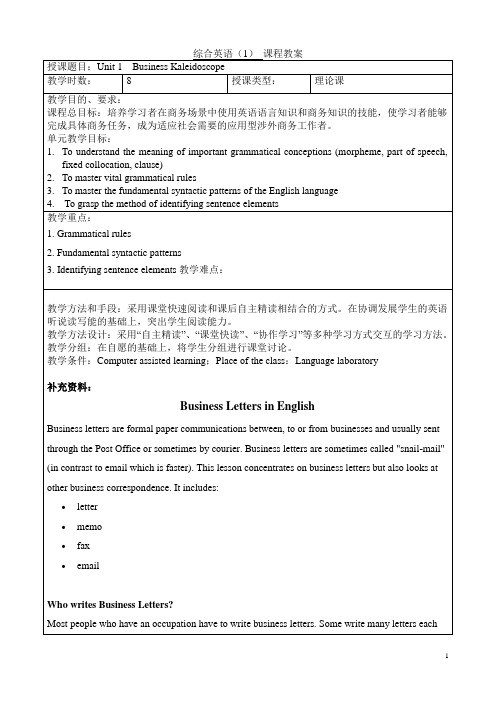
8. … a retail business might buy products from a wholesaler which in turn acquires them form a manufacturer… 零售商可以从批发商那里购买产品,而批g: Difficult sentence: 1. In fact, in modern society we are heavily dependent upon organized business activity.
在现代社会,我们十分依赖有组织的商业活动。
2. We are engaged in business activities every time we exchange our labor for wages and every time we use our wages to buy goods and services. 每当我们用劳动换取工资,并用工资来购买商品和服务时,我们就是在从事商业 活动。
3. … we make decisions that help determine the kinds of goods and services which business will provide… 我们所做的(购物)决定能促成企业决定提供何种产品和服务。
4. Although the subject of business may sound complicated, it is really an everyday part of our lives. 虽然商务这个主体可能听起来复杂,但是它确实是我们日常生活的一部分。
国际商务必读书单

国际商务必读书单要想成为国际商务师,读书时必不可少的,下面为大家整理了一些国际商务必读的书单,希望对你有所帮助!MNETheories - Monopolistic Advantage Theory1.Hymer,S.H. 1976. The international operations of national firms: A study of directforeign investment. Cambridge, MA: MIT Press.2.Aliber,R.A. 1970. A theory of foreign direct investment. InC.P. Kindelberger (Ed.),The International Operations. Cambridge, MA: MIT Press.3.Caves,R. 1971. International corporations: The industrial economics of foreigninvestment. Economica, 38: 1-27.4.Hennart,J-F. 2009. Theories of the multinational enterprises. In Alan Rugman (ed), TheOxford Handbook of International Business. Second Edition, Oxford University Press, 125-145.MNETheories -Internalization Theory1.Calvet,A. 1981. A synthesis of foreign direct investment theories and theories of themultinational firm. Journal of International Business Studies. 12(1): 43-59.2.Dunning,J. & Rugman, A. 1985. The influence of Hymer’s dissertation on the theoryof foreign direct investment. American Economic Review, 75(2): 228-232.3.Buckley,P. 1988. The limits of explanation: Testing internalization theory of themultinational enterprise. Journal of International Business Studies, 19(2):181-193.4.Horaguchi,H. & T oyne, B. 1990. Setting the record straight: Hymer, internalizationtheory and transaction cost economics. Journal of International BusinessStudies, 21(3): 487-494.5.Rugman,A. and Verbeke, A. 2003. Extending the theory ofthe multinational enterprise:internalization and strategic management perspectives, Journal of International Business Studies 34(2): 125-137. 6.6.Verbeke,A. 2003. The evolutionary view of the MNE and the future of internalizationtheory. Journal of International Business Studies, 34: 498-504.MNETheories - Liability of Foreignness View1.Zaheer,S. 1995. Overcoming the liability of foreignness. Academy of ManagementJournal, 38: 341-363. **2.Mezias,J. 2002. Identifying liabilities of foreignness and strategies to minimizetheir effects: The case of labor lawsuit judgments in the United States.Strategic Management Journal, 23(3): 229.Institutional View of MNEs1.Kostova,Tatiana and Zaheer, Srilata. (1999) ‘Organizational legitimacy under conditionsof complexity: The case of the multinational enterprise’, Academy of ManagementReview 24: 64-81. **2.Kostova,T. 1999. Transnational transfer of strategic & organizational practices: Acontextual perspective. Academy of Management Review, 24: 308-324.3.Busenitz,L, C. Gomez & J. Spencer. 2000. Country institutional profiles: Unlockingentrepreneurial phenomena. Academy of Management Journal, 43: 994-1003. **4.KostovaT. & K. Roth. 2002. Adoption of an organizational practice by thesubsidiaries of the MNC. Academy of Management Journal, 45(1): 215-233.5.Xu,D. & O. Shenkar. 2002. Institutional distance and the multinationalenterprise. Academy of Management Review, 27: 608-618.6.Meyer,K. & M. Peng. 2005. Probing theoretically into Central and Eastern Europe:transactions, resources, and institutions. JIBS, 36:600-621.Political Behavior View of MNEs1.Boddewyn,Jean. (1988) ‘Political Aspects of MNE Theory’, Journal of InternationalBusiness Studies 18(3) (Fall): 341-363. **2.Boddewyn,Jean and Brewer, Thomas. 1994. International business political behavior: Newtheoretical directions. Academy of Management Review, 19(1): 119-143.3.Hillman,Amy and Hitt, Michael. (1999) ‘Corporate political strategy formulation: A modeof approach, participation and strategy decisions’, Academy of ManagementJournal24(4): 825-842.4.Blumentritt,Timothy P. and Nigh, Douglas. (2002) ‘The Integration of Subsidiary PoliticalActivities in Multinational Corporations’, Journal of International BusinessStudies 33(1) (1st Quarter): 57-77.5.Habib,Mohsin and Zurawicki, Leon. (2002) ‘Corruption and Foreign Direct Investment’,Journal of International Business Studies 33(2) (2nd Quarter): 291-307.6.Hillman,Amy and Wan, William. (2005) ‘The determinants of MNE subsidiaries’ politicalstrategies: evidence of institutional duality’, Journal of InternationalBusiness Studies ***7.Luo,Yadong. 2006. Political behavior, social responsibility and corruptenvironment: A structuration perspective. Journal of International Business Studies, 37(6): 747-766.**Politics,Government and MNEs1.Fagre,N, Wells, L.T. (1982), "Bargaining power of multinationals and hostgovernments", Journal of InternationalBusiness Studies, Vol. 13 No.3,pp.9-23.2.Gomes-Casseres,B (1990), "Firm ownership preferences and host government restrictions: anintegrated approach", Journal of International Business Studies, Vol. 21No.1, pp.1-21.3.Luo,Y. (2001) ‘T owards a Cooperative View of MNC-Host Country Relations: BuildingBlocks and Performance Implications’, Journal of International Business Studies32(3) (3rd Quarter): 401-419.4.Ramamurti,Ravi. (2001) ‘The Obsolescing ‘Bargain Model’? MNC-Host Developing CountryRelations Revisited’, Journal of International Business Studies 32(1): 23-39.**5.Agmon,T. (2003) ‘Who gets what: the MNE, the national state and the distributiona leffects of globalization’, Journal of International Business Studies 34:416-427.Uppsala Model and Experience Perspective of Internationalization1.Johanson,J. and Vahlne, J. 1977. The internationalization process of the firm: A modelof knowledge development and increasing foreign market commitment. Journal ofInternational Business Studies, 8: 23-32.2.Anderson,O. 1993. On the internationalization process of firms: A critical analysis. Journalof International Business Studies, 24(2): 209-231. **3.Davidson,W. 1980. The location of foreign direct investment activity: Countrycharacteristics and experience effects. JIBS, 11:9-22.4.Erramilli,M.K. 1991. The experience factor in foreign market entry behavior of servicefirms. JIBS, 22: 479-502. ***5.Benito,G.R. and Gripsrud, G. 1992. The expansion of foreign direct investments:Discrete rational location choices or a culturallearning process? Journalof International Business Studies, 23:461-476.6.Chang,S.J. 1995. International expansion strategy of Japanese firms: Capabilitybuilding through sequential entry. AMJ, 38: 383-407. **7.Li,J.T. 1995. Foreign entry and survival: Effects of strategic choices onperformance in international markets, Strategic Management Journal, 16: 333-352.6.Barkema,H. G., Bell, J. H. and Pennings, J.M. 1996. Foreign entry, cultural barriersand learning. Strategic Management Journal, 17: 151-166.7.Barkema,H. G. and Vermeulen, F. 1998. International expansion through start-up oracquisitions. A learning perspective. AMJ, 41: 7-26.8.Luo,Yadong. 1998. Timing of investment and international expansion performance inChina. Journalof International Business Studies, 29(2): 391-408.Transaction Cost Economics (TCE) and Internationalization1.Anderson,E. and H. Gatignon. 1986. Modes of Foreign Entry – A Transaction Cost Analysisand Propositions. Journal of International Business Studies, 17.3: 1-26. **2.Zhao,Hongxin, Luo, Yadong and Suh, Taewon. (2004) ‘Transaction cost determinants andownership-based entry mode choice: a meta-analytical review’, Journal ofInternational Business Studies 35: 524-544.3.Luo,Y. 2005. Transactional characteristics, institutional environment and jointventure contracts. JIBS, 36(2): 209-230.**4.Agarwal,S. and S.N. Ramaswami. 1992. Choice of Foreign-Market Entry Mode –Impact ofOwnership, Location andInternalization Factors. Journal of InternationalBusiness Studies, 23.1: 1-27.5.Kim,W.C. and P. Hwang. 1992. Global Strategy and Multinationals: Entry Mode Choice.Journal of International Business Studies¸23.1: 29-53.6.Pan,Yigang and David Tse. 2000. The hierarchical model of market entry modes.Journal of International Business Studies, 31.4 (4th Quarter): 535-554.Cultural Distance Perspective and Internationalization1.Kogut,Bruce and Harbir Singh. 1988. The Effect of National Culture on the Choice ofEntry Mode. Journal of International Business Studies, 19.3: 411-32. **2.Tihanyi,Laszlo, David A Griffith and Craig J Russell. 2006. The effect of culturaldistance on entry mode choice, international diversification, and MNEperformance: a meta-analysis. Journal of International Business Studies,270-283.3.Shenkar,Oded, Luo, Yadong and Yeheskel, O. 2008. From “distance” to “friction”:Substituting metaphors and redirecting intercultural research. AMR, 33(4):905-923.Parent-SubsidiaryLink & I-R Balance View1.Ghoshal,S. and C.A. Bartlett. 1990. The Multinational Corporation as anInterorganizational Network, Academy of Management Review, 15 (4): 603-625. **2.Ghoshal,Sumantra and Bartlett, Christopher A. (1988) ‘Creation, adoption and diffusionof innovations by subsidiaries of multinational corporations,’ Journal ofInternational Business Studies 19(3): 365-388.3.Sundaram,Anant K. and Black, J. Stewart, (1992) ‘The environment and internalorganization of multinational enterprises,’ Academy of Management Review 17(4):729-757.4.Birkinshaw,Julian M. and Morrison, Alan J. (1995) ‘Configurations of strategy andstructure in subsidiaries of multinational corporations,’ Journal ofInternational Business Studies 26(4): 729-753. **5.Harzing,Anne-Wil (2000) ‘An empirical analysis and extension of the Bartlett andGhoshal typology of multinational companies,’ Journal of International BusinessStudies 31(1): 101-120.6.Luo,Yadong. 2003. Market-seeking MNEs in an emerging market: How parent-subsidiarylinks shape overseas success. JIBS, 34(3): 290-309.7.Kim,K., Park, J. H., & Prescott, J. E. 2003. The global integration of businessfunctions: A study of multinational businesses in integrated global industries.Journal of International Business Studies, 34(4): 327.Global Strategic Alliances& International Joint Ventures1.Inkpen,Andrew and Beamish, Paul. (1997) ‘Knowledge, Bargaining Power, and the Instabilityof International Joint Ventures’, Academy of Management Review 22(1) (January):177-202. **2.Luo,Yadong. 1997. Partner selection and venturing success: The case of jointventures with firms in the People's Republic of China. Organization Science,8(6): 648-662.3.Merchant,H. and Schendel D. (2000) How do international joint ventures create value?Strategic Management Journal, 21: 723-737.4.Luo,Yadong. 2001. Antecedents and consequences of personal attachment incross-cultural cooperative ventures. ASQ, 46(2): 177-201.5.Luo,Yadong, Oded Shenkar and M-K. Nyaw. 2001. A dualparent perspective on controland performance in international joint ventures. JIBS, 32(1):41-58.6.Luo,Yadong. 2002. Contract, cooperation, and performance in international jointventures. SMJ, 23(10): 903-920. **7.Luo,Yadong. 2007. The independent and interactive roles of procedural, distributiveand interactional justice in strategic alliances. AMJ, 50(3): 644-664.International Diversification and MNEs1.Kim,W., Hwang, P. & Burgers, W. 1989. Global diversification strategy andcorporate profit performance. Strategic Management Journal, 10: 45-57.2.Hitt,M., Hoskisson, R. & Kim, H. 1997. International diversification: Effects oninnovation and firm performance in product-diversified firms. Academy of Management Journal, 40(4): 767-796. **3.Contractor,Farok, Kundu, Sumit K. and Hsu, Chin-Chun. (2003) ‘A three-stage theory ofinternational expansion: the link between multinationality and performance inthe service sector’, Journal of International Business Studies 34: 5-18.4.Lu,J. and Beamish, P. 2004. International diversification and firm performance:The s-curve hypothesis. Academy of Management Journal, 47: 598-609. **5.Qian,Gongming, Lee Li, Ji Li and Zhengming Qian. 2008. Regional diversification andfirm performance. Journal of International Business Studies, 39(2): 197-214.Knowledge Management and MNEs1.Kogut,Bruce and Zander, Udo. (1993) ‘Knowledge of the Firm and the EvolutionaryTheory of the Multinational Corporation’, Journal of International BusinessStudies 24(4): 625-645. **2.Kogut,B. and Zander, U. 1995. Knowledge, market failure and the multinationalenterprise: A reply. Journal of International Business Studies, 26(2): 417-426.3.Singh,J. 2007. Asymmetry of knowledge spillovers between MNCs and host country firms.Journal of International Business Studies, 38(5): 764-686.Global Strategies and Emerging Markets1.Luo,Yadong and Mike W. Peng. 1999. Learning to compete in a transition economy:Experience, environment, and performance. JIBS, 30(2): 269-296.2.Meyer,Klaus. (2004) ‘Perspectives on multinational enterprises in e mergingeconomies’, Journal of International Business Studies 35: 259-276.3.Luo,Yadong and Tung, Rosalie. 2007. International expansion of emerging marketenterprises: A springboard perspective. JIBS, 38(4): 481-498. **4.Yiu,Daphne W., Chung Ming Lau and Gary D. Bruton. 2007. International venturing byemerging economy firms: the effects of firm capabilities, home countrynetworks, and corporate entrepreneurship. Journal of International BusinessStudies, 519-540.5.Luo,Yadong and Rui, H. 2009. An ambidexterity perspective toward multinationalenterprises from emerging economies. Academy of Management Perspective, 23(4):49-70.6.Luo,Yadong. 2007. From foreign investors to strategic insiders: Shiftingparameters, prescriptions and paradigms for MNCs in China. Journal of WorldBusiness, 42(1): 14-36.7.Cuervo-Cazurra,Alvaro; Genc, Mehmet. 2008: Transforming disadvantages into advantages:developing-country MNEs in the least developed countries. Journal of International BusinessStudies39.6: 957-979.**8.Zhang,Yan; Li, Haiyang; Li, Yu; Zhou, Li-An. 2010: FDI spillovers in an emerging market: the role of foreign firms'country origin diversity and domestic firms' absorptive capacity. Strategic Management Journal 31.9: 969.**9. Mesquita,Luiz F; Lazzarini, Sergio G. 2008: Horizontal and vertical relationships indeveloping economies: implications for SMEs' access to global markets. Academy of Management Journal 51.2: 359.。
